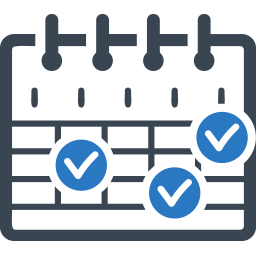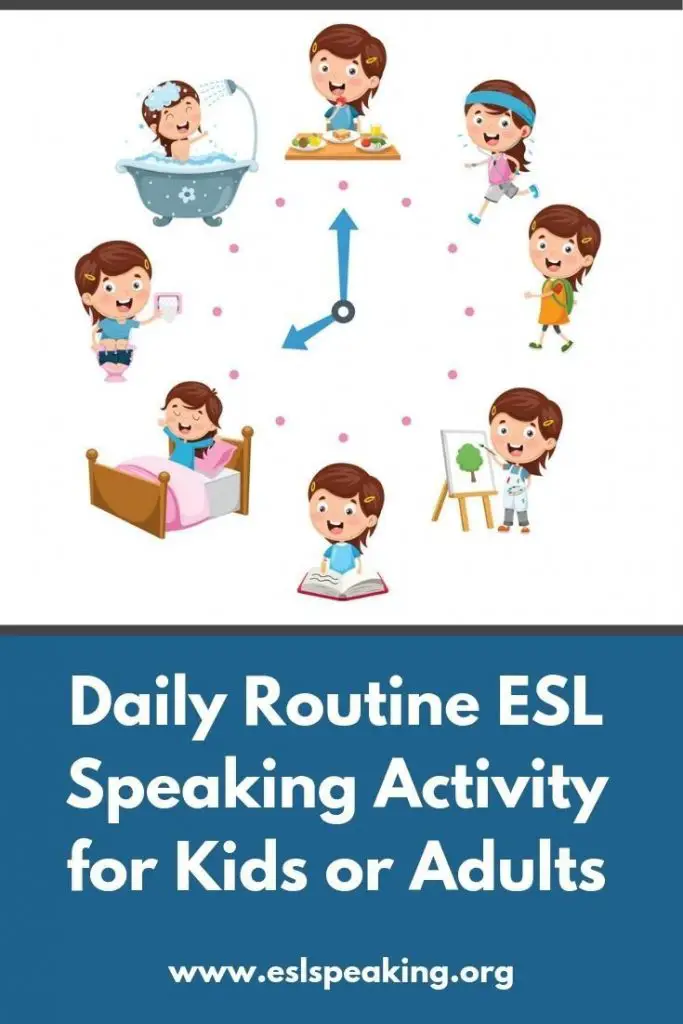If you want to know how to make the daily schedule unit that you can find it many ESL/EFL textbooks more interesting, then you’re in the right place. Keep on reading for everything daily routines ESL

Daily Schedule Activity
It seems like every single ESL textbook for kids (or even adults) has a section on daily routines. Getting up in the morning, eating breakfast, going to school or work, having lunch, etc. It can get a little bit boring if you don’t mix things up a bit for your students.
Check out this ESL daily routine speaking activity to make this old topic new again. Keep on reading for all the details you need to know about how to prep for it, what to do in class with your students and some teaching tips to make it as good as possible.
Daily Schedule ESL Speaking Activity
Skills: Speaking/listening/writing
Time: 10-20 minutes
Level: Beginner to Low-intermediate
Materials Required: Nothing
Here’s what you need to do for this daily routine ESL activity. It’s interactive, requires students to actually listen to their partner and is a fun way for students to get some freer practice with this topic.
Activity Description for ESL Daily Routine:
It seems that in most beginner ESL speaking or 4-skills textbooks there is a unit on daily schedules, such as, “What time do you get up?” or, “What do you do in the afternoon?”
A fun activity that you can do is to have students interview their partner. You can pre-select questions for lower level classes or let the students choose their own questions for higher levels. Make sure you specify a minimum number of questions if you let the students choose their own.
Have the students jot down a few notes as they go. Then, they have to close their notebooks, and in a group of four, they have to explain their partner’s daily schedule to the other pair in their group.
If the students are high enough level, you can give a quick reminder about reported speech. If not, let students use any English that they can to explain their partner’s daily schedule.
The other group can ask a follow-up question or two to the person whose schedule was talked about. I usually require each person listening to ask 1 question. This helps to encourage active listening and also gives students a chance to practice asking and answering some follow-up questions.
You can put some example questions on the board to help your beginner students with this. I usually highlight the 5 W’s and H (who, what, when, why, where, how).
Teaching Tips for Daily Activities ESL
This is an excellent activity to turn a boring topic into something that isn’t so terrible. Being able to talk about daily schedules is quite an important thing for our learners to be able to do, so ignore the temptation to just skip it when you come to it in your book.
Tip #1:
I usually give students a set amount of time to interview their partner such as 3 minutes x 2 = 6 minutes. So each person has to ask questions for three entire minutes and then answer questions for the same amount of time.
I emphasize that if the three minutes is not up, they can think of another 1-2 questions to ask. After the first three minutes, I’ll say, “Stop, change” so that students don’t have to keep track of the time themselves (they probably won’t).
Tip #2:
While reported speech is kind of a higher level concept, you can introduce it briefly in this activity and provide some concrete examples for students to follow. This happens when two teams join together and are reporting what they learned about their partner to the other pair. For example, “Jen said that she _____,” or “Tim told me that he _____.”
Tip #3
For beginner-level students, you will need to be very explicit about the kinds of questions and answers they could use and make sure they have access to examples of them, either in the textbook or on the whiteboard.
Procedure for this ESL Daily Routine Activity:
- Assign the task to the students, specifying if they must ask questions that you’ve prepared for them, or if they make their own and how many questions.
- Put students in pairs and they can interview their partner about their daily schedule, taking brief notes.
- Students switch interviewer/interviewee roles.
- Put each pair with another pair.
- Student A introduces Student B to the other pair. The other pair has a chance to ask some follow-up questions.
- Continue until all four student’s daily schedules have been introduced.
- The teacher can follow up with the class (optional). A fun way to do this is to ask each group to share the most interesting or surprising thing. A common answer is a student who gets up really, really early because they live so far away from the school.

Daily activities ESL activity
Did you like this ESL Speaking Activity for Daily Activities?
- Amazon Kindle Edition
- Bolen, Jackie (Author)
- English (Publication Language)
- 187 Pages - 03/09/2016 (Publication Date)
Yes? Thought so. Then you’re going to love this book over on Amazon, 101 ESL Activities: For Teenagers and Adults. It’s lesson planning made easy, guaranteed.
The book is neatly divided into sections: reading, speaking, 4-skills, warmups, etc., so you’ll be able to find what you’re looking for in seconds. Add some variety to your lessons and keep things interesting and fun for your students.
Each activity starts off with a brief overview that’ll allow you to see, at a glance if it’s right for your lesson. Then, you can read the step-by-step instructions for how to prepare for the activity before class, then what do during class with your students. Finally, don’t forget the handy teaching tips that’ll help you avoid the most common problems.
The book is available in both digital and print formats. Keep a hard copy on the bookshelf at school as a handy reference. Or, take a copy with you to go on your phone for lesson planning at home or in coffee shops. It’s up to you!
Check out 101 ESL Activities for yourself over on Amazon:
ESL Daily Routines FAQs
There are a number of common questions that people have about teaching this topic. Here are the answers to some of the most popular ones.
What is a daily routine?
A daily routine is a set of activities or tasks that a person does regularly, typically on a daily basis.
Why is teaching daily routines important in ESL?
Teaching daily routines helps ESL learners communicate effectively about their daily lives and understand common English conversations.
What are some common morning routines?
Common morning routines include waking up, brushing teeth, taking a shower, getting dressed, and having breakfast.
Can you give an example of a daily routine sentence?
Sure! “I wake up at 7:00 AM every morning.”
How can you teach daily routines to ESL beginners?
Use visuals, flashcards, and simple sentences. Start with basic routines like waking up and brushing teeth, and gradually introduce more activities.
What’s an evening routine?
An evening routine typically includes activities like having dinner, doing homework, watching TV, and going to bed.
How can you make teaching daily routines fun for ESL kids?
Use games, songs, and role-play activities. Encourage them to create their own routines and share them in English.
What are some common words and phrases related to daily routines?
Common words and phrases include “morning,” “afternoon,” “evening,” “brushing teeth,” “getting dressed,” “having lunch,” and “going to bed.”
How can you assess ESL students’ understanding of daily routines?
Use quizzes, worksheets, or ask students to describe their own daily routines in English.
Why is practicing daily routines important in ESL classes?
Practicing daily routines helps ESL learners build confidence in using everyday English, which is essential for daily communication.
Daily Schedule ESL Speaking Activity: Have your Say!
What do you think about this ESL daily routine speaking activity? Is it a good one or do you have another ESL schedule activity that you’d like to recommend? Leave a comment below and share your thoughts with us. We’d love to hear from you.
Also be sure to give this article a share on Facebook, Pinterest, or Twitter. It’ll help other teachers, like yourself find this useful teaching resource.

ESL daily routine speaking activity
Last update on 2025-06-24 / Affiliate links / Images from Amazon Product Advertising API






I have a unit on daily activities coming up with my elementary school students and found these activity ideas so awesome. Thanks so much for your recommendations!
Hi Jackie,
Thanks for this! You’re right Daily Schedule has been in every General English book that I’ve taught. I like how this cuts down on the Teacher Talk Time.